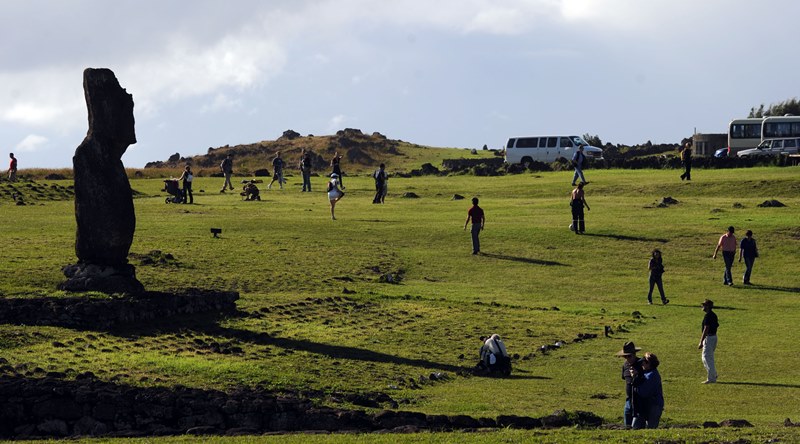From Old Town Lunenburg on the southern coast of Nova Scotia to the Galapagos Islands in Ecuador, dozens of World Heritage Sites are now at risk of being destroyed due to climate change, according to a United Nations report.

The United Nations Educational, Scientific and Cultural Organization (UNESCO) says 31 World Heritage sites in 29 countries are under threat from increasing temperatures, rising seas, intensifying weather events, worsening droughts and longer wildfire seasons.
Researchers said the damage done to these could deliver a blow to the tourism industries and the economies of the countries where the World Heritage sites are found.
READ MORE: As climate warms, grizzly bears and polar bears interbreed
Yellowstone National Park, located in the United States, Venice, Italy, Komodo National Park in Indonesia, Stonehenge, Chile’s Easter Island, and even the Statue of Liberty are among some of the sites listed as vulnerable to climate change.
“Some Easter Island statues are at risk of being lost to the sea because of coastal erosion. Many of the world’s most important coral reefs, including in the islands of New Caledonia in the western Pacific, have suffered unprecedented coral bleaching linked to climate change this year,” said Adam Markham, lead author of the report and deputy director of the Climate and Energy Program at UCS, in a statement.
“Climate change could eventually even cause some World Heritage sites to lose their status.”
READ MORE: Melting Antarctic glacier could raise sea levels by almost 3 metres, study warns
As of 2015, there are 1,031 sites in 163 countries on the World Heritage List according to UNESCO, and represent the “outstanding universal value” as they capture human cultural traditions, creative genius, history or exceptional natural phenomena.
The report comes on the heels of last year’s COP21 summit in Paris, where global leaders agreed to make sure the rise of global temperatures stayed well below 2 Celsius.
“World governments, the private sector and tourists all need to coordinate their efforts to reduce carbon emissions and to protect the world’s most treasured cultural and natural resources from the impact of tourism activities,” said Elisa Tonda, UNEP’s head of the Responsible Industry and Value Chains Unit.
Here is a look at five sites that could be threatened by climate change.
Old Town Lunenburg, Nova Scotia
Located on the southern coast of Nova Scotia, Lunenberg is the best example of a planned British colonial settlement townscape in North America. More than 1.8 million tourists visit Nova Scotia annually and tourism revenue on the south coast exceeds $ 160 million a year, with Lunenburg being one of the top destinations, according to UNESCO. Rising seas threaten some coastal land permanently from floods and storms surges.
Galápagos Islands, Ecuador
Consisting of an archipelago of 18 large islands, three smaller ones and more than 100 islets and rocks, Galápagos Islands are home to a wide array of diverse plant and animal species. While the main threats to the Islands in recent decades have been tourism, population growth, the introduction of invasive species, and illegal fishing, now climate change is also having an impact as rising sea levels, a warming atmosphere, and ocean acidification will have dire consequences for the islands’ ecosystems.
Statue of Liberty, U.S.A

One of the most recognizable statues on the planet, the Statue of Liberty National Monument and Ellis Island received 3.7 million visitors in 2011, supported 2,200 jobs and brought US$ 174 million into the economies of the states of New York and New Jersey, according to UNESCO. The statue is at risk to rising sea levels and extreme weather events.
Bwindi Impenetrable Forest National Park, Uganda
Home to just under half of the endangered mountain gorillas left in wild Uganda’s Bwindi Impenetrable Forest National Park is vulnerable due to a combination of climate change and tourism, UNESCO said. This could put the great apes at a greater risk of catching human diseases and researchers predict that as the mountains warm and farmers move up the slopes, great apes will have less jungle to roam, making each gorilla band more likely to encounter tourists.
Stonehenge, U.K.

Stonehenge, located in southern England, is considered to be one of the most remarkable Stone Age remains anywhere in the world, UNESCO said. One of the largest and most architecturally sophisticated stone circles on Earth, climate change has led to increasing rainfall, heavier rains, and worsening flash floods that can damage the site and impact visitors to the site.
- ‘Significant risk’: How will wildfires spread over the next two months?
- As Canada eyes AI growth, could electricity demands fuel climate change?
- London Drugs issues apology, says no evidence of compromised data in cyberattack
- B.C. fruit likely to be in short supply and expensive this year: produce retailers







Comments